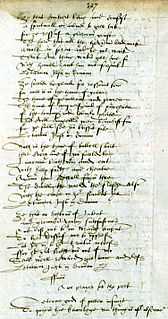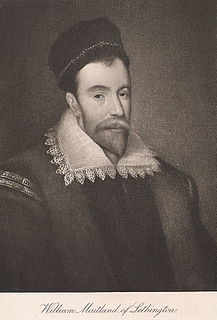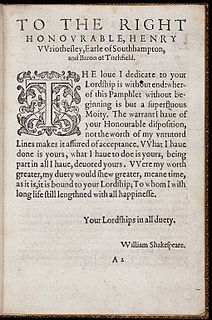
The earliest texts of William Shakespeare's works were published during the 16th and 17th centuries in quarto or folio format. Folios are large, tall volumes; quartos are smaller, roughly half the size. The publications of the latter are usually abbreviated to Q1, Q2, etc., where the letter stands for "quarto" and the number for the first, second, or third edition published.

George Bannatyne (1545–1608), a native of Angus, Scotland, was an Edinburgh merchant and burgess. He was the seventh of twenty-three children, including Catherine Bannatyne, born of James Bannatyne of Kirktown of Newtyle in Forfarshire and Katherine Tailefer. He is most famous as a collector of Scottish poems. He compiled an anthology of Scots poetry while in isolation during a plague in 1568. His work extended to eight hundred folio pages, divided into five parts. The anthology includes works from Scottish Chaucerians as well as many anonymous writers.

The Shakespeare apocrypha is a group of plays and poems that have sometimes been attributed to William Shakespeare, but whose attribution is questionable for various reasons. The issue is separate from the debate on Shakespearean authorship, which addresses the authorship of the works traditionally attributed to Shakespeare.
Octavo, a Latin word meaning "in eighth" or "for the eighth time", is a technical term describing the format of a book, which refers to the size of leaves produced from folding a full sheet of paper on which multiple pages of text were printed to form the individual sections of a book. An octavo is a book or pamphlet made up of one or more full sheets on which 16 pages of text were printed, which were then folded three times to produce eight leaves. Each leaf of an octavo book thus represents one eighth the size of the original sheet. Other common book formats are folios and quartos. Octavo is also used as a general description of the size of books that are about 8 to 10 inches tall, and as such does not necessarily indicate the actual printing format of the books, which may even be unknown as is the case for many modern books. These terms are discussed in greater detail in book sizes.

Mr. William Shakespeare's Comedies, Histories, & Tragedies is a collection of plays by William Shakespeare, published in 1623, commonly referred to by modern scholars as the First Folio. It is considered one of the most influential books ever published.

William Maitland of Lethington was a Scottish politician and reformer, and the eldest son of poet Richard Maitland. He was educated at the University of St Andrews.

The size of a book is generally measured by the height against the width of a leaf, or sometimes the height and width of its cover. A series of terms is commonly used by libraries and publishers for the general sizes of modern books, ranging from folio, to quarto (smaller) and octavo. Historically, these terms referred to the format of the book, a technical term used by printers and bibliographers to indicate the size of a leaf in terms of the size of the original sheet. For example, a quarto historically was a book printed on a sheet of paper folded twice to produce 1 leaf, each leaf one fourth the size of the original sheet printed. Because the actual format of many modern books cannot be determined from examination of the books, bibliographers may not use these terms in scholarly descriptions.

A critical apparatus in textual criticism of primary source material, is an organized system of notations to represent, in a single text, the complex history of that text in a concise form useful to diligent readers and scholars. The apparatus typically includes footnotes, standardized abbreviations for the source manuscripts, and symbols for denoting recurring problems.

A bad quarto, in Shakespearean scholarship, is a quarto-sized printed edition of one of Shakespeare's plays that is considered to be unauthorised, and is theorised to have been pirated from a theatrical performance without permission by someone in the audience writing it down as it was spoken or, alternatively, written down later from memory by an actor or group of actors in the cast – the latter process has been termed "memorial reconstruction". Since the quarto derives from a performance, hence lacks a direct link to the author's original manuscript, the text would be expected to be "bad", i.e. to contain corruptions, abridgements and paraphrasings.
The authority of a text is its reliability as a witness to the author's intentions. These intentions could be initial, medial or final, but intentionalist editors generally attempt to retrieve final authorial intentions. The concept is of particular importance for textual critics, whether they believe that authorial intention is recoverable, or whether they think that this recovery is impossible.
Shakespeare's editors were essential in the development of the modern practice of producing printed books and the evolution of textual criticism.
The Beaumont and Fletcher folios are two large folio collections of the stage plays of John Fletcher and his collaborators. The first was issued in 1647, and the second in 1679. The two collections were important in preserving many works of English Renaissance drama.
William Leake, father and son, were London publishers and booksellers of the late sixteenth and the seventeenth centuries. They were responsible for a range of texts in English Renaissance drama and poetry, including works by Shakespeare and Beaumont and Fletcher.

Quarto is a book or pamphlet produced from full sheets printed with eight pages of text, four to a side, then folded twice to produce four leaves. The leaves are then trimmed along the folds to produce eight book pages. Each printed page presents as one-fourth size of the full sheet.

The term "folio", from the Latin folium (leaf), has three interconnected but distinct meanings in the world of books and printing: it is firstly a term for a common method of arranging sheets of paper into book form, folding the sheet only once, and a term for a book made in this way; secondly it is a general term for a sheet, leaf or page in (especially) manuscripts and old books; and thirdly it is an approximate term for the size of a book, and for a book of this size.
Theodorus Priscianus was a physician at Constantinople during the 4th century, and the author of the Latin work Rerum Medicarum Libri Quatuor.

The spelling of William Shakespeare's name has varied over time. It was not consistently spelled any single way during his lifetime, in manuscript or in printed form. After his death the name was spelled variously by editors of his work, and the spelling was not fixed until well into the 20th century.
The Bewties Of The Fute-ball is a brief, anonymous Middle Scots poem of the sixteenth century. It depicts the game of medieval football, as it was played in the same era, as being violent and unruly.

Mary Maitland was a Scottish writer believed to be the transcriber of the Quarto Volume of the Maitland Manuscripts, an important source for the Scots literature of the Fifteenth and Sixteenth Centuries. She recorded and preserved her father's extensive writings as his sight became increasingly poor, eventually resulting in his blindness.
The Cambridge Shakespeare is a long-running series of critical editions of William Shakespeare's works published by Cambridge University Press. The name encompasses three distinct series: The Cambridge Shakespeare (1863–1866), The New Shakespeare (1921–1969), and The New Cambridge Shakespeare (1984–).












